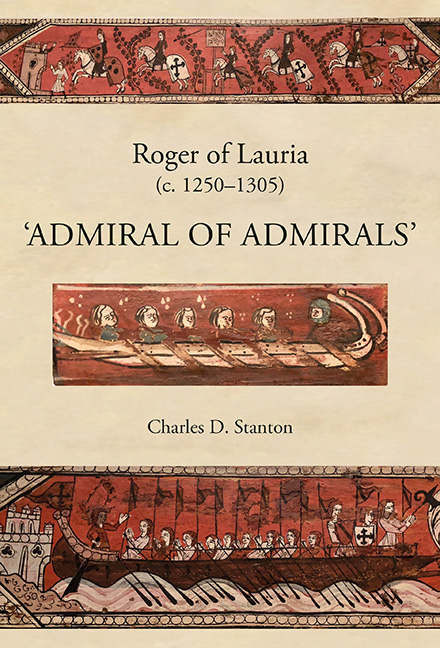Book contents
- Frontmatter
- Dedication
- Contents
- List of Illustrations
- Prologue
- 1 Battle of Benevento (26 February 1266)
- 2 A Calabrian Exile in the Court of Aragon (1262–1282)
- 3 Battle of Tagliacozzo (23 August 1268)
- 4 Aragonese Expansion (1229–1282)
- 5 Angevin Consolidation and Aggrandizement (1268–1282)
- 6 Revolt of the Vespers (30 March 1282)
- 7 Aragonese Intervention (August–October 1282)
- 8 Stalemate (November 1282–March 1283)
- 9 Admiral of Aragon (20 April 1283)
- 10 The Opposing Fleets (1282–1302)
- 11 Battle of Malta (8 June 1283)
- 12 Anjou's Dreams of Empire Dashed (June–November 1284)
- 13 France's Crusade Against Aragon (May–November 1285)
- 14 Battle of the Counts (23 June 1287)
- 15 Truces and Treaties (June 1287–November 1291)
- 16 Raid on Romania (Summer 1292)
- 17 Switching Sides (December 1293–April 1297)
- 18 Aragon's Invasion of Sicily at Anjou's Bidding (1298/1299)
- 19 Lauria's Last Great Campaign (Summer 1299–Spring 1300)
- 20 Endgame (Spring 1301–Summer 1302)
- Epilogue
- Bibliography
- Index
1 - Battle of Benevento (26 February 1266)
Published online by Cambridge University Press: 24 October 2019
- Frontmatter
- Dedication
- Contents
- List of Illustrations
- Prologue
- 1 Battle of Benevento (26 February 1266)
- 2 A Calabrian Exile in the Court of Aragon (1262–1282)
- 3 Battle of Tagliacozzo (23 August 1268)
- 4 Aragonese Expansion (1229–1282)
- 5 Angevin Consolidation and Aggrandizement (1268–1282)
- 6 Revolt of the Vespers (30 March 1282)
- 7 Aragonese Intervention (August–October 1282)
- 8 Stalemate (November 1282–March 1283)
- 9 Admiral of Aragon (20 April 1283)
- 10 The Opposing Fleets (1282–1302)
- 11 Battle of Malta (8 June 1283)
- 12 Anjou's Dreams of Empire Dashed (June–November 1284)
- 13 France's Crusade Against Aragon (May–November 1285)
- 14 Battle of the Counts (23 June 1287)
- 15 Truces and Treaties (June 1287–November 1291)
- 16 Raid on Romania (Summer 1292)
- 17 Switching Sides (December 1293–April 1297)
- 18 Aragon's Invasion of Sicily at Anjou's Bidding (1298/1299)
- 19 Lauria's Last Great Campaign (Summer 1299–Spring 1300)
- 20 Endgame (Spring 1301–Summer 1302)
- Epilogue
- Bibliography
- Index
Summary
WHEN CHARLES, COUNT OF ANJOU and brother of King Louis IX of France, emerged with his assembled forces from the Samnite Apennines to arrive on the east shoulder of Monte San Vitale just above the fortified city of Benevento on the afternoon of 25 February 1266, his heart must have sunk. There, camped beneath the walls of the city on the south side of the swollen River Calore, was the entire army of his archenemy: Manfred, King of Sicily. He had not expected him to be there.
Charles had just marched his army from Rome, where on the day of the Epiphany (6 January) he had been anointed by the papacy to assume Manfred's crown. His objective was Naples, Manfred's residence and unofficial capital. So he had taken the Via Latina, an old Roman road that ran through Frosinone and Anagni. He faced little resistance as he crossed the River Liri at Ceprano. On 10 February his invading army had even captured the seemingly impregnable castle of Cassino (called San Germano at the time) from a detachment of 2,000 Saracens sent by Manfred to hold the pass. But there he learned that Manfred was waiting in force behind a heavily fortified bridge on the Volturno River near Capua, which blocked the main access route into the Regno (the medieval appellation for the Kingdom of Sicily – from the Italian word regno, meaning ‘kingdom’). Deciding that the most prudent course of action was to flank Manfred to the east, Charles diverted his legions eastward past Telese into the rugged Taburno Camposauro Mountains and through the narrow defile of Vitulano just west of Benevento. It was a horrific miscalculation. The track made for an arduous trek in the dead of winter. Seasonal downpours had turned mountain streams into raging torrents. Most of his supply wagons had to be abandoned. By the time his men stumbled out into the Calore Valley, they had devoured most of their beasts of burden and even some of their destriers (the costly warhorses of the knights). It was a drained and dispirited force that now faced a well-rested and well-fed adversary, protected by a nearly impassable river in the shadow of a well-defended city.
- Type
- Chapter
- Information
- Roger of Lauria (c.1250–1305)‘Admiral of Admirals’, pp. 9 - 24Publisher: Boydell & BrewerPrint publication year: 2019

